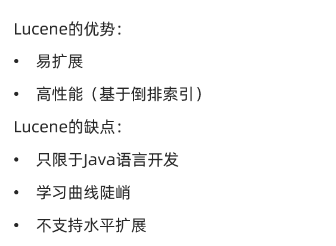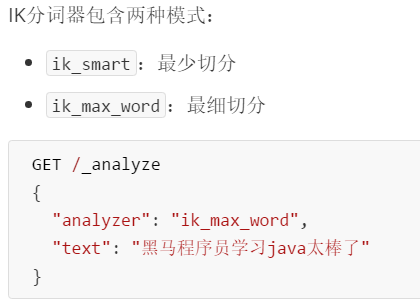elasticsearch是什么?
一个开源的分布式搜索引擎,可以用来实现搜索、日志统计、分析、系统监控等功能
elasticsearch可以解决什么问题?
elasticsearch是一款非常强大的开源搜索引擎,具备非常多强大功能,可以帮助我们从海量数据中快速找到需要的内容
ELK技术栈
elasticsearch结合kibana、Logstash、Beats,也就是elastic stack(ELK)。被广泛应用在日志数据分析、实时监控等领域
而elasticsearch是elastic stack的核心,负责存储、搜索、分析数据。
elasticsearch底层是基于lucene来实现的。

总结
什么是elasticsearch?
一个开源的分布式搜索引擎,可以用来实现搜索、日志统计、分析、系统监控等功能
什么是elastic stack(ELK)?
是以elasticsearch为核心的技术栈,包括beats、Logstash、kibana、elasticsearch
什么是Lucene?
是Apache的开源搜索引擎类库,提供了搜索引擎的核心API
elasticsearch怎么用?
1.正向索引和倒排索引:
正向索引是最传统的,根据id索引的方式。但根据词条查询时,必须先逐条获取每个文档,然后判断文档中是否包含所需要的词条,是根据文档找词条的过程。
- 而倒排索引则相反,是先找到用户要搜索的词条,根据词条得到保护词条的文档的id,然后根据id获取文档。是根据词条找文档的过程。
正向索引:
- 优点:
- 可以给多个字段创建索引
- 根据索引字段搜索、排序速度非常快
- 缺点:
- 根据非索引字段,或者索引字段中的部分词条查找时,只能全表扫描。
倒排索引:
- 优点:
- 根据词条搜索、模糊搜索时,速度非常快
- 缺点:
- 只能给词条创建索引,而不是字段
- 无法根据字段做排序
2.mysql与elasticsearch
| MySQL | Elasticsearch | 说明 | | —- | —- | —- | | Table | Index | 索引(index),就是文档的集合,类似数据库的表(table) | | Row | Document | 文档(Document),就是一条条的数据,类似数据库中的行(Row),文档都是JSON格式 | | Column | Field | 字段(Field),就是JSON文档中的字段,类似数据库中的列(Column) | | Schema | Mapping | Mapping(映射)是索引中文档的约束,例如字段类型约束。类似数据库的表结构(Schema) | | SQL | DSL | DSL是elasticsearch提供的JSON风格的请求语句,用来操作elasticsearch,实现CRUD |
是不是说,我们学习了elasticsearch就不再需要mysql了呢?
并不是如此,两者各自有自己的擅长支出:
- Mysql:擅长事务类型操作,可以确保数据的安全和一致性
- Elasticsearch:擅长海量数据的搜索、分析、计算
因此在企业中,往往是两者结合使用:
IK分词器有几种模式?
- ik_smart:智能切分,粗粒度
- ik_max_word:最细切分,细粒度
IK分词器如何拓展词条?如何停用词条?
- 利用config目录的IkAnalyzer.cfg.xml文件添加拓展词典和停用词典
-
索引库操作
1.mapping映射属性
mapping是对索引库中文档的约束,常见的mapping属性包括:
type:字段数据类型,常见的简单类型有:
- 字符串:text(可分词的文本)、keyword(精确值,例如:品牌、国家、ip地址)
- 数值:long、integer、short、byte、double、float、
- 布尔:boolean
- 日期:date
- 对象:object
- index:是否创建索引,默认为true
- analyzer:使用哪种分词器
- properties:该字段的子字段
例如下面的json文档:
{"age": 21,"weight": 52.1,"isMarried": false,"info": "黑马程序员Java讲师","email": "zy@itcast.cn","score": [99.1, 99.5, 98.9],"name": {"firstName": "云","lastName": "赵"}}
对应的每个字段映射(mapping):
- age:类型为 integer;参与搜索,因此需要index为true;无需分词器
- weight:类型为float;参与搜索,因此需要index为true;无需分词器
- isMarried:类型为boolean;参与搜索,因此需要index为true;无需分词器
- info:类型为字符串,需要分词,因此是text;参与搜索,因此需要index为true;分词器可以用ik_smart
- email:类型为字符串,但是不需要分词,因此是keyword;不参与搜索,因此需要index为false;无需分词器
- score:虽然是数组,但是我们只看元素的类型,类型为float;参与搜索,因此需要index为true;无需分词器
name:类型为object,需要定义多个子属性
- name.firstName;类型为字符串,但是不需要分词,因此是keyword;参与搜索,因此需要index为true;无需分词器
- name.lastName;类型为字符串,但是不需要分词,因此是keyword;参与搜索,因此需要index为true;无需分词器
2.索引库的CRUD
2.1创建索引库和映射
PUT /heima { "mappings": { "properties": { "info":{ "type": "text", "analyzer": "ik_smart" }, "email":{ "type": "keyword", "index": "false" }, "name":{ "properties": { "firstName": { "type": "keyword" } } } } } }2.2.查询索引库
GET /索引库名2.3.修改索引库
PUT /索引库名/_mapping { "properties": { "新字段名":{ "type": "integer" } } }2.4.删除索引库
DELETE /索引库名总结
索引库操作有哪些?
创建索引库:PUT /索引库名
- 查询索引库:GET /索引库名
- 删除索引库:DELETE /索引库名
-
文档操作
1.新增文档
POST /heima/_doc/1 { "info": "黑马程序员Java讲师", "email": "zy@itcast.cn", "name": { "firstName": "云", "lastName": "赵" } }2.查询文档
GET /heima/_doc/13.删除文档
# 根据id删除数据 DELETE /heima/_doc/14.修改文档
修改有两种方式:
全量修改:直接覆盖原来的文档
-
4.1.全量修改
全量修改是覆盖原来的文档,其本质是:
根据指定的id删除文档
- 新增一个相同id的文档
注意:如果根据id删除时,id不存在,第二步的新增也会执行,也就从修改变成了新增操作了。
PUT /heima/_doc/1
{
"info": "黑马程序员高级Java讲师",
"email": "zy@itcast.cn",
"name": {
"firstName": "云",
"lastName": "赵"
}
}
4.2.增量修改
POST /heima/_update/1
{
"doc": {
"email": "ZhaoYun@itcast.cn"
}
}
总结
文档操作有哪些?
- 创建文档:POST /{索引库名}/_doc/文档id { json文档 }
- 查询文档:GET /{索引库名}/_doc/文档id
- 删除文档:DELETE /{索引库名}/_doc/文档id
修改文档:
- 全量修改:PUT /{索引库名}/_doc/文档id { json文档 }
- 增量修改:POST /{索引库名}/_update/文档id { “doc”: {字段}}
RestAPI
ES官方提供了各种不同语言的客户端,用来操作ES。这些客户端的本质就是组装DSL语句,通过http请求发送给ES。官方文档地址:https://www.elastic.co/guide/en/elasticsearch/client/index.html
其中的Java Rest Client又包括两种:
Java Low Level Rest Client
- Java High Level Rest Client
我们学习的是Java HighLevel Rest Client客户端API
几个特殊字段说明:
- location:地理坐标,里面包含精度、纬度
- all:一个组合字段,其目的是将多字段的值 利用copy_to合并,提供给用户搜索 ```json PUT /hotel
{ “mappings”: { “properties”: { “id”: { “type”: “keyword” }, “name”:{ “type”: “text”, “analyzer”: “ik_max_word”, “copy_to”: “all” }, “address”:{ “type”: “keyword”, “index”: false }, “price”:{ “type”: “integer” }, “score”:{ “type”: “integer” }, “brand”:{ “type”: “keyword”, “copy_to”: “all” }, “city”:{ “type”: “keyword”, “copy_to”: “all” }, “starName”:{ “type”: “keyword” }, “business”:{ “type”: “keyword” }, “location”:{ “type”: “geo_point” }, “pic”:{ “type”: “keyword”, “index”: false }, “all”:{ “type”: “text”, “analyzer”: “ik_max_word” } } } }
<br />all里面包含name,brand,city三个字段的所有分词的结果;<br />当使用all搜索时,就相当于在name,brand,city三个字段中搜索,只要有一个满足,就可以查出来。
<a name="IB69B"></a>
## 使用RestClient步骤如下
<a name="VRQqo"></a>
## 使用RestClient操作索引库:
<a name="AXOjO"></a>
### 1.初始化RestClient:
在elasticsearch提供的API中,与elasticsearch一切交互都封装在一个名为RestHighLevelClient的类中,必须先完成这个对象的初始化,建立与elasticsearch的连接。<br />分为三步:<br />1)引入es的RestHighLevelClient依赖:
```json
<dependency>
<groupId>org.elasticsearch.client</groupId>
<artifactId>elasticsearch-rest-high-level-client</artifactId>
</dependency>
2)因为SpringBoot默认的ES版本是7.6.2,所以我们需要覆盖默认的ES版本:
<properties>
<java.version>1.8</java.version>
<elasticsearch.version>7.12.1</elasticsearch.version>
</properties>
3)初始化RestHighLevelClient:
初始化的代码如下:
RestHighLevelClient client = new RestHighLevelClient(RestClient.builder(
HttpHost.create("http://192.168.150.101:9200")
));
这里为了单元测试方便,我们创建一个测试类HotelIndexTest,然后将初始化的代码编写在@BeforeEach方法中:
package cn.itcast.hotel;
import org.apache.http.HttpHost;
import org.elasticsearch.client.RestHighLevelClient;
import org.junit.jupiter.api.AfterEach;
import org.junit.jupiter.api.BeforeEach;
import org.junit.jupiter.api.Test;
import java.io.IOException;
public class HotelIndexTest {
private RestHighLevelClient client;
@BeforeEach
void setUp() {
this.client = new RestHighLevelClient(RestClient.builder(
HttpHost.create("http://192.168.150.101:9200")
));
}
@AfterEach
void tearDown() throws IOException {
this.client.close();
}
}
2.创建索引库
@Test
void createHotelIndex() throws IOException {
// 1.创建Request对象
CreateIndexRequest request = new CreateIndexRequest("hotel");
// 2.准备请求的参数:DSL语句
request.source(MAPPING_TEMPLATE, XContentType.JSON);
// 3.发送请求
client.indices().create(request, RequestOptions.DEFAULT);
}
-- 创建索引库代码
package cn.itcast.hotel;
import cn.itcast.hotel.config.HotelConstants;
import org.apache.http.HttpHost;
import org.elasticsearch.client.RequestOptions;
import org.elasticsearch.client.RestClient;
import org.elasticsearch.client.RestHighLevelClient;
import org.elasticsearch.client.indices.CreateIndexRequest;
import org.elasticsearch.client.indices.CreateIndexResponse;
import org.elasticsearch.common.xcontent.XContentType;
import org.junit.jupiter.api.AfterAll;
import org.junit.jupiter.api.AfterEach;
import org.junit.jupiter.api.BeforeEach;
import org.junit.jupiter.api.Test;
import java.io.IOException;
public class EsIndexDemo {
@Test
public void createIndex() throws IOException {
//创建索引库
CreateIndexRequest request = new CreateIndexRequest("hotel");
request.source(HotelConstants.MAPPING_TEMPLATE, XContentType.JSON);
CreateIndexResponse response = client.indices().create(request, RequestOptions.DEFAULT);
System.out.println(response.isAcknowledged());
}
RestHighLevelClient client;
@BeforeEach
public void init() {
//准备好es的客户端对象
client = new RestHighLevelClient(RestClient.builder(
HttpHost.create("http://192.168.200.130:9200")
));
}
@AfterEach
public void close() {
try {
client.close();
} catch (IOException e) {
e.printStackTrace();
}
}
}
3.删除索引库
DELETE /hotel
@Test
void testDeleteHotelIndex() throws IOException {
// 1.创建Request对象
DeleteIndexRequest request = new DeleteIndexRequest("hotel");
// 2.发送请求
client.indices().delete(request, RequestOptions.DEFAULT);
}
4.判断索引库是否存在
判断索引库是否存在,本质就是查询,对应的DSL是:
GET /hotel
@Test
void testExistsHotelIndex() throws IOException {
// 1.创建Request对象
GetIndexRequest request = new GetIndexRequest("hotel");
// 2.发送请求
boolean exists = client.indices().exists(request, RequestOptions.DEFAULT);
// 3.输出
System.err.println(exists ? "索引库已经存在!" : "索引库不存在!");
}
总结
JavaRestClient操作elasticsearch的流程基本类似。核心是client.indices()方法来获取索引库的操作对象。
索引库操作的基本步骤:
- 初始化RestHighLevelClient
- 创建XxxIndexRequest。XXX是Create、Get、Delete
- 准备DSL( Create时需要,其它是无参)
- 发送请求。调用RestHighLevelClient#indices().xxx()方法,xxx是create、exists、delete
RestClient操作文档
1.初始化RestHighLevelClient
package cn.itcast.hotel;
import cn.itcast.hotel.pojo.Hotel;
import cn.itcast.hotel.service.IHotelService;
import org.junit.jupiter.api.AfterEach;
import org.junit.jupiter.api.BeforeEach;
import org.junit.jupiter.api.Test;
import org.springframework.beans.factory.annotation.Autowired;
import org.springframework.boot.test.context.SpringBootTest;
import java.io.IOException;
import java.util.List;
@SpringBootTest
public class HotelDocumentTest {
@Autowired
private IHotelService hotelService;
private RestHighLevelClient client;
@BeforeEach
void setUp() {
this.client = new RestHighLevelClient(RestClient.builder(
HttpHost.create("http://192.168.150.101:9200")
));
}
@AfterEach
void tearDown() throws IOException {
this.client.close();
}
}
1.新增文档
我们导入酒店数据,基本流程一致,但是需要考虑几点变化:
- 酒店数据来自于数据库,我们需要先查询出来,得到hotel对象
- hotel对象需要转为HotelDoc对象
- HotelDoc需要序列化为json格式
- 把HotelDoc对象中的数据转换为JSON格式后存入ES索引库
因此,代码整体步骤如下:
- 1)根据id查询酒店数据Hotel
- 2)将Hotel封装为HotelDoc
- 3)将HotelDoc序列化为JSON
- 4)创建IndexRequest,指定索引库名和id
- 5)准备请求参数,也就是JSON文档
6)发送请求
@Test void testAddDocument() throws IOException { // 1.根据id查询酒店数据 Hotel hotel = hotelService.getById(61083L); // 2.转换为文档类型 HotelDoc hotelDoc = new HotelDoc(hotel); // 3.将HotelDoc转json String json = JSON.toJSONString(hotelDoc); // 1.准备Request对象 IndexRequest request = new IndexRequest("hotel").id(hotelDoc.getId().toString()); // 2.准备Json文档 request.source(json, XContentType.JSON); // 3.发送请求 //添加文档:clent.index client.index(request, RequestOptions.DEFAULT); }2.查询文档
@Test void testGetDocumentById() throws IOException { // 1.准备Request GetRequest request = new GetRequest("hotel", "61082"); // 2.发送请求,得到响应 GetResponse response = client.get(request, RequestOptions.DEFAULT); // 3.解析响应结果 String json = response.getSourceAsString(); HotelDoc hotelDoc = JSON.parseObject(json, HotelDoc.class); System.out.println(hotelDoc); }3.删除文档
@Test void testDeleteDocument() throws IOException { // 1.准备Request DeleteRequest request = new DeleteRequest("hotel", "61083"); // 2.发送请求 client.delete(request, RequestOptions.DEFAULT); }4.修改文档
@Test void testUpdateDocument() throws IOException { // 1.准备Request UpdateRequest request = new UpdateRequest("hotel", "61083"); // 2.准备请求参数 request.doc( "price", "952", "starName", "四钻" ); // 3.发送请求 client.update(request, RequestOptions.DEFAULT); }5.批量导入文档
@Test void testBulkRequest() throws IOException { // 批量查询酒店数据 List<Hotel> hotels = hotelService.list(); // 1.创建Request BulkRequest request = new BulkRequest(); // 2.准备参数,添加多个新增的Request for (Hotel hotel : hotels) { // 2.1.转换为文档类型HotelDoc HotelDoc hotelDoc = new HotelDoc(hotel); // 2.2.创建新增文档的Request对象 request.add(new IndexRequest("hotel") .id(hotelDoc.getId().toString()) .source(JSON.toJSONString(hotelDoc), XContentType.JSON)); } // 3.发送请求 BulkResponse bulk = client.bulk(request, RequestOptions.DEFAULT); System.out.println(bulk.status());//ok代表成功 }小结
文档操作的基本步骤:
初始化RestHighLevelClient
- 创建XxxRequest。XXX是Index、Get、Update、Delete、Bulk
- 准备参数(Index、Update、Bulk时需要)
- 发送请求。调用RestHighLevelClient#.xxx()方法,xxx是index、get、update、delete、bulk
- 解析结果(Get时需要)


